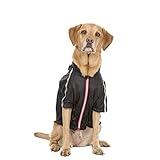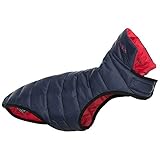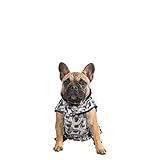How To Maintain Your Dog’s Weight in Winter
Maintaining your pet’s optimum weight is always important, but it can be more difficult in winter when your dog might not be as enthusiastic about exercising. Not all dogs love winter walks so watching their weight can be difficult.
Keeping your dog at a healthy weight is very important for owners, as it can really help with maintaining their overall health and happiness. Being at a healthy weight lowers your pet’s risk of diabetes, high blood pressure, respiratory disease, and much more (Heart.org). A balance of healthy eating and plenty of exercise can usually keep your pooch at their optimum weight, but this can become more difficult in winter when we don’t get outside as much.
It might be tempting to do the minimum length of walk you can or your dog just might not want to run around as much on their outings, even if you give them plenty of time. So, how can you keep an eye on your dog’s weight this winter?
There are a few things you can do to help your dog stay healthy and fit during the winter months. Make sure they get a check-up from their veterinarian to ensure they’re in good health, monitor their food intake to make sure they don’t gain any excess weight, and get them some outdoor gear to keep them warm during walks. You may also need to shorten outdoor walks or find indoor activities to keep them occupied and active.
In this guest post, Michael Haigh from the pet experts Webbox will offer some tips on maintaining your dog’s weight.
Get a check-up before winter
Getting a check-up with your dog’s vet before the colder weather begins in earnest can help you know where you’re starting from in terms of your dog’s weight and health. Check that your dog is a healthy weight already and ascertain if there are any pre-existing conditions that might contribute to your pet gaining weight. This way, if your pet does gain some weight during the winter, you’ll know that it’s probably seasonal factors rather than any underlying health conditions.
In this routine check-up you’ll also be able to note down your dog’s pre-winter weight and ask your vet how to maintain that weight over winter. Getting tips from a professional is invaluable when looking after your pet’s health. You can then monitor your dog’s weight throughout the winter by weighing them at home to check that it doesn’t fluctuate too much.
Monitor your dog’s food intake
You should be monitoring your dog’s calorie intake throughout the year, but it’s particularly important in winter when your pooch might be getting less exercise. Remember that your dog’s weight will be determined by their calorie intake versus the calories they burn, so take note of how high or low-calorie their food is and make adjustments if needed. Choosing nutritious foods and sticking to set mealtimes (without many snacks in between) can also help to keep your dog’s intake at a comfortable and healthy level.
If you find that your dog is gaining weight, try switching their food to a lower-calorie alternative and make sure that you are only using treats for training and not too regularly throughout the day. Snacks should also be as healthy and low-calorie as possible to ensure that they aren’t eating a lot of extra food on top of their meals.
Get your dog some outdoor gear
To help your dog remain active throughout the winter, it’s important to invest in the gear that they’ll need to keep them warm and comfortable on their walks. Getting your dog a coat that can keep the chill off them and protect them from the rain can help them to feel comfortable on their walks, and enjoy being outside more. This will encourage them to keep running around just as they did in the summer months, helping them remain a healthy weight.
You can also get your dog boots for when the roads and parks are too icy and cold for their paws. Some also come with some extra grip built in, allowing your pooch to run more without slipping. Many dogs find these boots difficult to get used to, but if you introduce them to your dog slowly and give them time to adjust, you might find that they really take to them. Failing that, fleeces and waterproof coats for your dog can also make a real difference to their exercise time.
| Image | Title | Price | Buy |
|---|---|---|---|
 | Ancol Muddy Paws Stormguard Coat Chocolate | View on Amazon | |
 | Rantow Reflective Dog Coat Winter Vest Loft Jacket | View on Amazon | |
 | Trespaws Lloyd Dog Puffer Jacket | View on Amazon | |
 | Trespaws Khaos Waterproof Dog Coat | View on Amazon | |
 | Trespaws Hercules Windproof 2 in 1 Dog Coat | View on Amazon | |
 | Trespaws BOOMER - DOG FLEECE | View on Amazon | |
 | Trespaws Kimmi Quilted Reversible Packaway Dog Coat | View on Amazon | |
Top | Trespaws Dogby Down Dog Coat | View on Amazon | |
 | Trespaws CHARLY - PRINTED DOG RAIN COAT | View on Amazon |
Plan shorter walks
A good strategy for keeping your pet active is to plan shorter, more frequent walks throughout the day. This will allow you to cumulatively get the right amount of exercise for your dog without them getting too cold, as they won’t have to spend a long time outside without being able to warm up.
Instead of walking them, you can also take your dog into the back garden for some games like fetch and other short modes of exercise. This will allow you to keep your dog moving while being close enough to the house to take them inside if they begin to look cold.
Keep an eye on your dog when you’re outside to check they aren’t uncomfortable, shivering, or showing other signs of being chilly, and bring them back inside to warm up if they do look like the cold is getting to them.
Create indoor activities
Even if it’s too cold to go outside, you can entertain your pooch indoors and get them active to ensure they aren’t missing out too much on their exercise time. Tug-of-war and fetch can be played indoors, and you can even create an indoor agility course using household items, such as brooms, blankets, and chairs. This can be an excellent workout for your dog and be fun for you and the family as well!
Some dogs will be more encouraged to exercise if they are mentally stimulated, so things like puzzle toys and training sessions that include new tricks can really encourage your pooch to move and learn.
Interactive toys can also be a great option, but the main thing is to keep your four-legged friend moving throughout the winter months even if it’s too cold to go outdoors for long. A dog training or agility class is also a wonderful option for indoor exercise and mental stimulation.
Wrapping up
Use these tips to ensure that your dog maintains their optimum weight throughout the winter months, and to find alternative ways to exercise when it’s too cold and icy outside. By wrapping your dog up warm, keeping to a healthy meal routine, and taking time to keep them active inside, you can help your pooch stay at a healthy weight throughout the colder weather.

